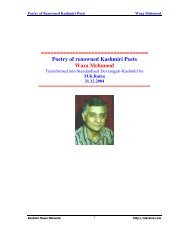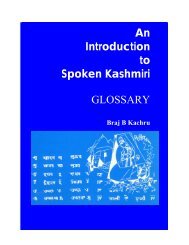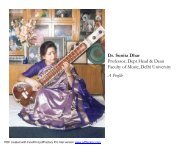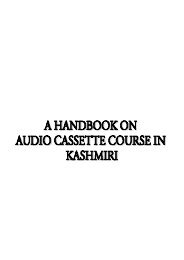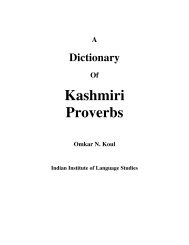Introductory Pages - An Introduction to Spoken Kashmiri
Introductory Pages - An Introduction to Spoken Kashmiri
Introductory Pages - An Introduction to Spoken Kashmiri
Create successful ePaper yourself
Turn your PDF publications into a flip-book with our unique Google optimized e-Paper software.
II. THE SOUNDS OF KASHMIRI<br />
<strong>Introduction</strong><br />
<strong>An</strong> <strong>Introduction</strong> <strong>to</strong> <strong>Spoken</strong> <strong>Kashmiri</strong><br />
by Braj B. Kachru<br />
In this section, we shall discuss the sounds of <strong>Kashmiri</strong>, and provide illustrations <strong>to</strong> give the<br />
learner the basic idea of these sounds. A detailed drill-oriented section, entitled Pronunciation<br />
Practice (see.2.0), follows this section. It is expected that both the teacher and the student will<br />
concentrate on that section both the teacher and student will concentrate on that section in order<br />
<strong>to</strong> focus on the particular sounds which a learner might in order <strong>to</strong> focus ont he particular<br />
sounds which a learner might find difficult. The only way <strong>to</strong> learn a non-native sound is <strong>to</strong><br />
understand its production, and then drill until a native speaker or language is satisfied that it is a<br />
close approximation of the sounds.<br />
The sounds of <strong>Kashmiri</strong> have been divided in<strong>to</strong> two main sections: vowels and consonants.<br />
Vowels<br />
There are eight vowels in <strong>Kashmiri</strong>, i.e.<br />
a) two high vowels, front and back: i and u<br />
b) two mid vowels, front and back: e and o<br />
c) one lower-mid back vowel: N<br />
d) three central vowels, high, mid, and low: 0, ? and a.<br />
All eight vowels have long forms. Note the following.<br />
i) i and i: are high front unrounded vowels. These are close <strong>to</strong> Hindi-Urdu i as in milna: ‘<strong>to</strong><br />
meet; and i: as in asli: ‘real’.<br />
They are also like the vowels in English bit and beat, respectively.<br />
In kashmiri i and i: are in free-variation with palatalized glides yi and yi: in initial position.<br />
Consider, for example, insa:n yinsa:n ‘a man’ and idra:r ~ yidra:r ‘urine’. In initial position i<br />
and i: are found in the speech of educated kashmiri speakers, while yi and yi: have a high<br />
frequency in the speech of uneducated kashmiris. This may be partly due <strong>to</strong> the infulence or<br />
Hindi- Urdu.<br />
In learning kashmiri as a second or foreign language, it may be. desirable <strong>to</strong> focus on i and i: in<br />
initial positions rather than on yi and yi:<br />
Examples:<br />
i insa:n man<br />
imtiha:n examination, test<br />
bihun <strong>to</strong> sit down<br />
khir rice pudding<br />
© 2006 Braj B. Kachru (http://kachru.com) 10<br />
http://koshur.org/<strong>Spoken</strong><strong>Kashmiri</strong>



